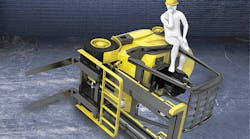For anybody thinking of applying for a warehousing or distribution job, the Internet can be a very scary place. With just a few clicks, a person can learn the following statistics:
- Of the 4,585 fatal occupational injuries in the U.S. in 2013, 1,184 (26%) occurred within transportation or material handling occupations. That's right: 1 out of every 4 employees killed in the U.S. work in material handling and logistics, according to the U.S. Bureau of Labor Statistics.
- In OSHA's ranking of the top 10 safety violations in the workplace, forklifts came in fifth, as OSHA reported more than 3,100 violations involving forklifts in 2014.
- More than 94,000 forklift injuries occur every year, with roughly 25% of those attributed to lack of operator training.
Little wonder that finding and retaining warehousing talent is the biggest challenge for material handling and logistics professionals. The good news is that fatalities and accidents are both down from previous years, but getting the word out to the public that warehouses are getting safer has proven to be a challenge unto itself.
In preparation for this year's event, several ITA members weighed in on the current state of forklift safety, focusing particularly on the need to involve all stakeholders on not only promoting safety but ensuring it's part of a company's culture.
The Value of Training
Since the introduction of the redefined "Powered Industrial Truck Operator Training Standard" (PITOT) in 1998-99, the material handling industry as a whole has become a much safer workplace, observes David Nicolette, technical trainer with Clark Material Handling Co. (www.clarkmhc.com), but there's still plenty more that needs to be done. "Some employers have caught on and realized the true intent of the PITOT standard and have instituted a continuing ‘Refresher Training' program that addresses the current issues in their particular workplace." Such programs are particularly important in those workplaces where these issues could change almost on a daily basis, he notes.
"However, too many employers still view a forklift as an automobile, and if the employee can drive an automobile, why can't they drive a forklift? Because of this thought process, the PITOT Standard becomes nothing more than another regulation they must comply with or possibly face the consequences."
It's easy to identify these types of employers just by entering their facilities, Nicolette says. "When you look around you will see, among other things, dimly-lit areas, rough floors, little or no supervision in the dock areas, overhead obstructions, possibly bent storage racks, and the forklifts will have scratches and dents all over them."
The PITOT must be a continuous effort, he stresses, not just an event once every three years. "If the workplace is in the same shape as the one I just mentioned, you know what the employer thinks about forklift operations in their workplace, and if the employer thinks in that manner you can be assured that all of the employees think the same way."
"There are many companies doing a great job at promoting forklift safety to their employees," observes Cesar Jimenez, director of product planning, technical & warranty with Toyota Material Handling, U.S.A., Inc. (www.toyotaforklift.com). "Unfortunately, there are others who just go through the motions of training." The best approach to preventing lift truck accidents, he says, is one that "combines proper operator training, equipment maintenance and every person, business and organization involved in material handling tasks strictly adhering to safety regulations."
Jimenez believes that training is necessary to make sure that operators understand how to properly operate a lift truck and how to handle the materials they will be handling. "Operators need to make sure they are aware of a lift truck's capabilities and limitations. In addition, operators need to be fully aware of their surroundings and what pedestrians around them are—and are not—seeing, hearing and thinking as they walk through a warehouse or factory."
Safety by Design
"Over the years we have seen dramatic improvements in forklift designs that meet operation demands for product deliveries," says Aurelio Carinci, vice president of sales & marketing with Bolzoni Auramo Inc. (www.bolzoni-auramo.us), a manufacturer of lift truck attachments. "The forklift manufacturers have worked closely with their supply base to understand the paramount way to deliver a product that meets or exceeds the user expectations, with safety as a top priority in the design. I don't believe it stops here either. The user is always looking for the edge to improve their throughput and the lift truck manufacturers have to deliver the request and demand, understanding that a forklift operator adds a lot of value to the success of the total execution."
Because of the operator's role in ensuring the proper use of the forklift, the operator is the most important feature in lift trucks, points out Toyota's Jimenez. "They are at the forefront of making sure that the forklift is used for its intended purpose—moving product from point A to B in the safest and most efficient manner possible."
Specific to the forklift design itself, Jimenez cites a number of features that can improve ergonomics, productivity and safety:
Ergonomics/comfort: Electronic finger-tip controls, full-suspension seats, arm-rests, rear-assist grips.
Productivity/efficiency: Telematics/warehouse management systems, AC motors, programmable performance characteristics, fork leveling capabilities, height indicators, height select features, and attachments such as side shifters, fork positioners.
Safety: Overhead guards, seat belts, operator presence sensing systems, and special systems such as Toyota's System of Active Stability.
According to Clark's Nicolette, "The design and the operation of the forklift are driven by the developments taking place in the work environment. All work environments are continuously changing, so the designs and operations of a forklift are continuously changing with it."
At Clark, the forklift design focuses on advance technologies and ideas for forklift safety, productivity, and product life span, Nicolette says. "We work very closely with our dealers and their customers to design the correct forklift for their particular operations. By using our complete customer network and bringing it together with our engineers and designers, we are able to shorten development time and accelerate product innovation. Safety is a top priority during the entire design and development of the material handling equipment in order to help protect both the customer's operator and their pedestrians."
Jimenez agrees that the design process must include pedestrians. "Pedestrians have a responsibility to be familiar with the operating characteristics of a forklift as well as the difficulties an operator faces from fatigue, lack of concentration, and visibility challenges. If you have employees that work around or near an area where forklifts are operated, please train them," he urges.
Building a Safety Culture
"We need to start training employers on how important a safe forklift operation is to their workplace and profits, and how a good forklift operator training program will reduce costs and increase profits," Nicolette urges. "The better we can personalize the safety awareness and practices, the stronger the effect will be on the users and operators. Technology is becoming available, such as interactive dash displays, warning systems and warning devices, that will enable the forklift manufacturers to engage the user and the operator while they are in their particular workplace and keep their focus on material handling safety."
National Forklift Safety Day represents a big step in that direction, he says, because it enables both the forklift manufacturers and OSHA to visibly highlight forklift safety through various programs.
The event serves as a focal point for manufacturers to highlight the safe use of forklifts and the importance of operator training, adds Jimenez. "It also provides an opportunity for the industry to educate customers, policymakers and the administration on forklift operating safety practices."







